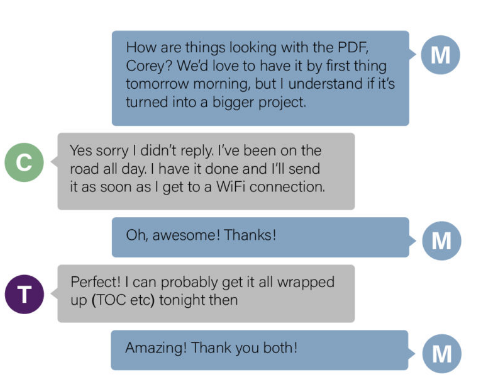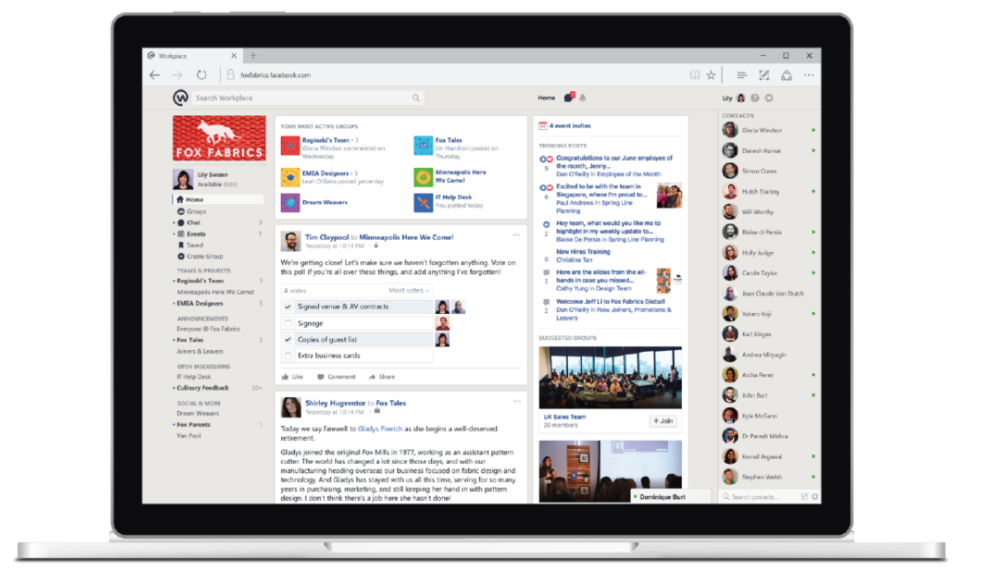11.3: Team-Focused Messages
- Page ID
- 4164
What you’ll learn to do: Discuss the importance of team-focused communication in business.
Teams are becoming the standard vehicle of productivity in the workplace; therefore, team-building and team focused messages are more important than ever. We will explore how team-focused messages can be crafted to be most effective. Also, we will focus on what means are used to allow teams to communicate across locations.
Learning Outcomess
- Discuss the purpose and use cases of team-focused messages in a business context
- Write a short team-focused message
- Write a long team-focused message
What is a Team-Focused Message?
Before we can understand the purpose and use of team-building communication, we should start with a discussion of the importance of collaborative teams in today’s workplace.
There are multiple benefits of collaborative teams versus individuals working independently. First, we notice an increase in creativity due to the sharing of different ideas, experiences and expertise. Every employee brings a certain body of skills and knowledge to the group. Shared knowledge and complementary skills are strong tools to be used to handle complex projects and assignments. The more the team talks about a project, the more ideas are generated. Having the perspective of several colleagues trumps the individual having only one set of ideas.
Secondly, we see an increase in productivity from collaborative and empowered teams. In the technology industry for example, high-performing teams are the norm in the workplace. The team works with the business owner to decide exactly what work is committed to be completed in a set amount of time. The team then works together to break down the work into manageable tasks. During that work cycle, the team talks every day about their progress and work may be shifted between team members based on availability and expertise. As the team remains together over several work cycles, there is a measurable increase in the amount of work the team can accomplish.
Other benefits of collaborative teams are:[1]
- Teams promote a wider sense of ownership.
- Teams encourage healthy risk-taking.
- Teams contribute to employee satisfaction and retention.
Given the benefits of collaborative teams in the workplace, the key is how organizations can create the proper environment to foster team creation, collaboration and growth. The right conditions have to exist to encourage trust, camaraderie, and the sharing of experience and expertise. Team-focused communication is a key component in successful teams.
Team-focused communication messages can take a variety of forms including IM, text, chat, email, video, audio, and document sharing. Team-focused messages can be short or long, casual or formal, but they must always be professional. Since teams are usually geographically distributed, virtual and/or remote, companies must provide the tools and platforms to promote and facilitate team communication.
Practice Question
Write a professional IM to team member Jeff informing him about a meeting tomorrow at 10:00am to discuss a new project.
Write your essay response here:
- Answer
-
Hello Jeff. We have been assigned an important new project. We have a meeting tomorrow to discuss. Will 10am work for you?
Starbucks recently adopted a team communication platform from Facebook called Workplace in order to foster organic, peer-to-peer collaboration. After only several months, Starbucks report that more than 80% of the organization’s store managers use the platform weekly. You can see from the case study how important team-focused communication can be in the workplace.
“In early 2017, when one store manager commented on a popular off-the-menu beverage, other managers chimed in and soon 40 other managers said this secret beverage was increasing in demand. That night, the category marketing team at Starbucks HQ saw the comment thread and, based on the drink’s popularity, decided to make it an official menu item. What usually takes several months was possible in less than 24 hours, thanks to the collaboration through Workplace.”[2]

Short Team-Focused Message
Since interactivity is a key to teamwork, a chat environment is a great team-focused communication platform. Short team messages can be communications such as status updates, meeting requests, notes of appreciation, or a invitations to a meet-up after work. Giving the team a way to respond as a group can be important in order to get everyone’s ideas and opinions in the same message thread. Figure 1 shows three team members commenting on the status of a PDF.

Figure 1. Chat between three collaborating team members
A short team-focused message can also be in the form of an email, especially for quick file attachment sharing to multiple team members.
To: Jeffrey Penrod
CC: Matt King, Joe Abbott, Mary Thomas
Subject: Here are the notes from today’s meeting
From: Tom Eastmen
Attachment: Meeting Notes 5-2-17.docx
Hello All,
As promised, the notes from today’s session with the customer are attached.
Thank you,
Tom
Tom Eastmen
Product Manager
XYZ Inc.
Team-focused communication is a great vehicle to keep team members informed, ensure projects are moving, and ultimately achieve strong results. Given all of the technology available in the workplace today, it is even easier than ever to create and send messages to your colleagues. One caveat: be aware and considerate of your teammates personal space. If you send an email, don’t text or IM right away to ask if they received your message. Don’t bother your colleagues after hours or on weekends unless you have mutually agreed to do so.
Practice Question
Compose a short chat message to the team informing them that Jack Wilson has been added to the group for this project. Assume that Jack is now included in the message distribution and announce the team will have a video meet at 4:00pm to virtually meet him.
Write your essay response here:
- Answer
-
Welcome Jack to the team! Let’s meet at 4 in our virtual room for introductions. Please be prepared to update Jack and the rest of the team as to status.
Long Team-Focused Message
When considering how to communicate a fair amount of information to your team, it is wise to step back and consider which channel would be best, not only to send your message but also to allow for your colleagues to comment and interact with the rest of the team. Here is an example of a long message to a technical team sent via email.
Hi Team,
I had the opportunity to talk to some customers about our primary competitor’s new product. Here are some of the areas where it may fall short based on the feedback. Many people agree that Product X is easy to use and adopt. The problem is you also need to provide access and views for other users and roles across many teams so that the whole organization can view performance.
Product Managers using Product X complain that there is no way for them to manage a single backlog for multiple teams or report back on how the teams are doing on higher-level initiatives. As PM’s you need a lot more than issue tracking to manage the growth and development of your product line.
Portfolio Managers involved in setting strategy are limited with Product X on how to represent investment themes in an agile enterprise. They need more visibility than just an iteration or two of work. The need would be for more layers than just a stream of customer requests and defects.
For Development Managers and Engineering Managers, Product X doesn’t provide them the ability to do capacity planning. At the root of that is the ability to get a good understanding of their team’s velocity—something that is not possible if you can’t split stories across multiple iterations. In the Product X world, you have to move the whole story if you can’t finish the story in one iteration. As a result, stories languish across multiple iterations, and the whole concept of velocity is lost. With no understanding of a team’s velocity, productivity improvements and predictability metrics are lost as well. With no capacity planning across multiple teams, or people split among teams, Manager’s struggle with their ability to manage people and resources needed.
to meet their commitments.
Program Managers complain that they are “swimming in a sea of user stories” that are not associated with higher-level objectives. There is no concept of a multiple project hierarchy.
I will keep you posted when I receive more feedback.
Thanks,
Ellie
What can we say about this message? Yes, it is long and contains much detail. The author has broken it up nicely with boldface headings to make it more readable. Besides using email to send this message, what other means could the author use to inform the team in the most interactive way? Certainly short message forms like IM, text, and chat would not be appropriate for the volume of information.
A report, blog, podcast or document- sharing repository could handle the amount of information, but each would have some drawbacks. Reports are good for large amounts of data but are not interactive in nature. Podcasts would also be good for the first viewing, but they are static, and the information is not searchable. A blog could be a good answer because it could become a “living” document for team members to append as more information about the competitor’s product become available. The drawbacks of using a blog in this scenario would be managing hundreds of such blogs being used for multiple topics as well as quickly finding the blog you want in the corporate wiki. The same drawbacks could be in play with standard document-sharing technology when you have hundreds or thousands of emails or documents to handle.
The best way to send and manage long, team-focused messages could be to take advantage of some of the new team collaboration software platforms. Applications like Stride, Slack, Workplace, Flowdock and others help teams keep related information—whether it is received as a IM, chat, email, report, or podcast—organized by topic or subject category, including the feedback from team members adding new content or commenting on existing material. (See Module 9: Communicating Through Technology for more information on collaboration software/multi-feature online platforms.)
Figure 1 shows Facebook’s Workplace. All of the messages, chats and announcements on the page look to be general team information. For a specific project, you could envision everything on a page having to do with that project—e.g. emails, team chats, links to related outside articles, links to related areas in the wiki—collected in one place.

Figure 1. Workplace by Facebook is just one collaboration platform you could use
Practice Question
What should you consider before sending a long written message to your team colleagues?
- Who should proof-read the message before it is sent?
- Where are your colleagues located?
- What is the optimum communication channel to inform and invite feedback?
- Answer
-
What is the optimum communication channel to inform and invite feedback?
- The Lean Startup, Eric Ries, 2011www.sandler.com/blog/6-benefits-of-teamwork-in-the-workplace] ↵
- [www.facebook.com/workplace/c...ies/starbucks] ↵

